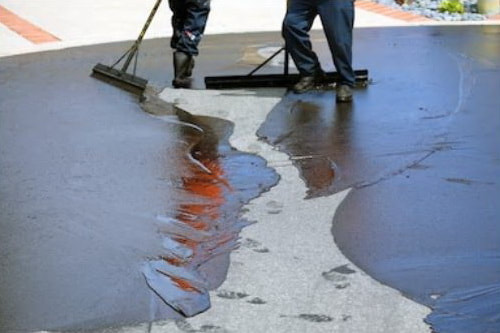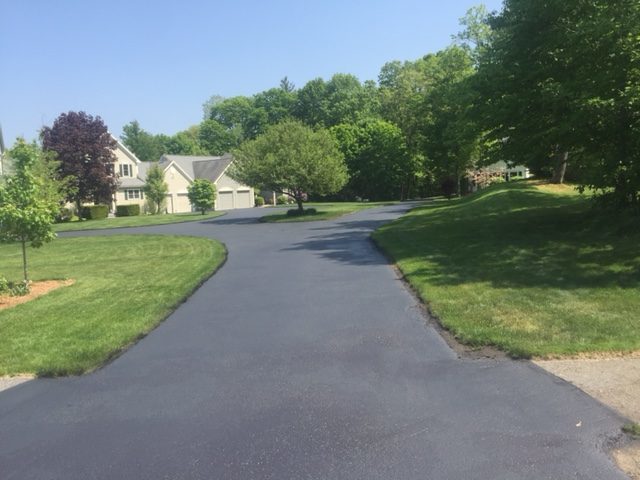Release the Possible: Regrading and Asphalt Sealing for Commercial Areas
Wiki Article
Warm Mix Asphalt: A Lasting Option for Sidewalk
Warm Mix Asphalt (HMA) has arised as a leading sustainable option for pavement remedies, providing a myriad of environmental advantages and cutting-edge innovations. As the demand for eco-friendly building practices expands, exploring the subtleties of HMA's sustainability can offer beneficial insights right into the future of pavement options.Environmental Advantages of Hot Mix Asphalt

Moreover, Hot Mix Asphalt assists to mitigate city heat island results. Its dark color takes in sunshine, minimizing the quantity of heat mirrored back into the environment compared to lighter-colored pavements. This can decrease ambient temperatures in metropolitan locations, decreasing the need for air conditioning and eventually lowering energy usage.
Furthermore, Warm Mix Asphalt adds to improved stormwater management. Its porous nature enables water to penetrate the sidewalk and reenergize groundwater supplies, decreasing overflow and the danger of flooding. These ecological advantages make Warm Mix Asphalt a lasting selection for leading roadways and freeways.
Energy Effectiveness in HMA Manufacturing
Is power effectiveness a vital consider the manufacturing of Warm Mix Asphalt (HMA)? Absolutely. Energy plays a considerable function in the production of HMA, affecting both expense and environmental sustainability. One essential aspect of energy efficiency in HMA manufacturing is making use of cozy mix asphalt (WMA) modern technologies (commercial parking lot paving). WMA permits for the blending and placement of asphalt at lower temperatures compared to typical hot mix asphalt, resulting in reduced power consumption during manufacturing. This procedure not only lowers fuel usage but likewise reduces greenhouse gas emissions, making it a more eco pleasant choice.In addition, developments in plant modern technologies have led to more energy-efficient HMA manufacturing processes. By enhancing power use in HMA production, the market can lower its carbon footprint while preserving high-grade pavement materials.
Recyclability of Hot Mix Asphalt
The recyclability of Hot Mix Asphalt (HMA) is a crucial element of its sustainability and long-term ecological impact. HMA is among one of the most recycled products in the basics United States, with over 100 million lots of redeemed asphalt pavement (RAP) being reused yearly in brand-new sidewalk building go now and construction. Recycling HMA provides a number of ecological advantages, such as lowering the need for virgin materials, reducing energy usage throughout manufacturing, and lowering the quantity of waste sent out to land fills.The procedure of recycling HMA involves crushing the existing sidewalk, crushing it into smaller sized items, and mixing it with new accumulation and asphalt binder to produce a recycled mix. In general, the recyclability of HMA plays a substantial role in promoting sustainable methods within the sidewalk industry.

Long-Term Performance of HMA
Asphalt sidewalks demonstrate toughness and resilience over an extensive period, mirroring the long-term efficiency of Warm Mix Asphalt (HMA) Furthermore, advancements in HMA innovation, such as the usage of polymer-modified binders and cozy mix asphalt, have actually further enhanced the resilience and long life of HMA pavements. By focusing on quality building and construction and maintenance methods, HMA proceeds to prove itself as a lasting and cost-effective solution for resilient sidewalk infrastructure.
HMA: Longevity and Sustainability
Showing both resilience and sustainability, Warm Mix Asphalt (HMA) has actually become a keystone in the building of long-lasting sidewalk infrastructures - commercial parking lot paving. HMA's sturdiness stems from its capacity to endure hefty loads, rough weather, and high web traffic quantities, making it a reputable selection for roads, freeways, and airport paths. The composition of HMA, which commonly includes accumulations, binder, and filler, plays an essential function in enhancing its durability and resistance to tear and wear
Additionally, HMA's sustainability hinges on its recyclability and energy-efficient production procedure. The capacity to reuse recovered asphalt sidewalk (RAP) in new HMA combinations reduces the demand for virgin products and minimizes the environmental effect of sidewalk construction and maintenance. Furthermore, the power performance of producing HMA depends on its lower blending temperatures compared to other pavement materials, causing lowered energy consumption and greenhouse gas discharges.
Final Thought
In conclusion, warm mix asphalt (HMA) offers a lasting option for pavement with its environmentally pleasant features. HMA's recyclability, energy efficiency in manufacturing, and lasting toughness make it an environment-friendly option for road building and construction.
HMA is one of the most recycled products in the United States, with over 100 million loads of reclaimed asphalt sidewalk (RAP) being reused annually in his comment is here brand-new pavement building and construction.The process of recycling HMA entails milling the existing sidewalk, crushing it right into smaller items, and blending it with new accumulation and asphalt binder to create a recycled mix.Asphalt sidewalks demonstrate longevity and durability over an extensive period, mirroring the long-lasting efficiency of Hot Mix Asphalt (HMA) In addition, improvements in HMA technology, such as the usage of polymer-modified binders and cozy mix asphalt, have better improved the longevity and durability of HMA sidewalks. The ability to recycle redeemed asphalt pavement (RAP) in brand-new HMA mixtures reduces the demand for virgin products and minimizes the ecological influence of pavement building and construction and upkeep.
Report this wiki page